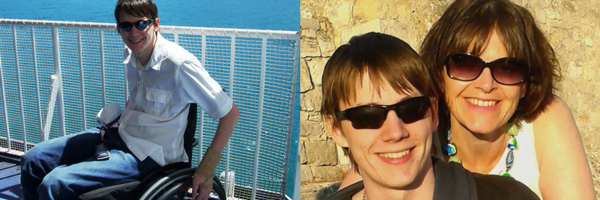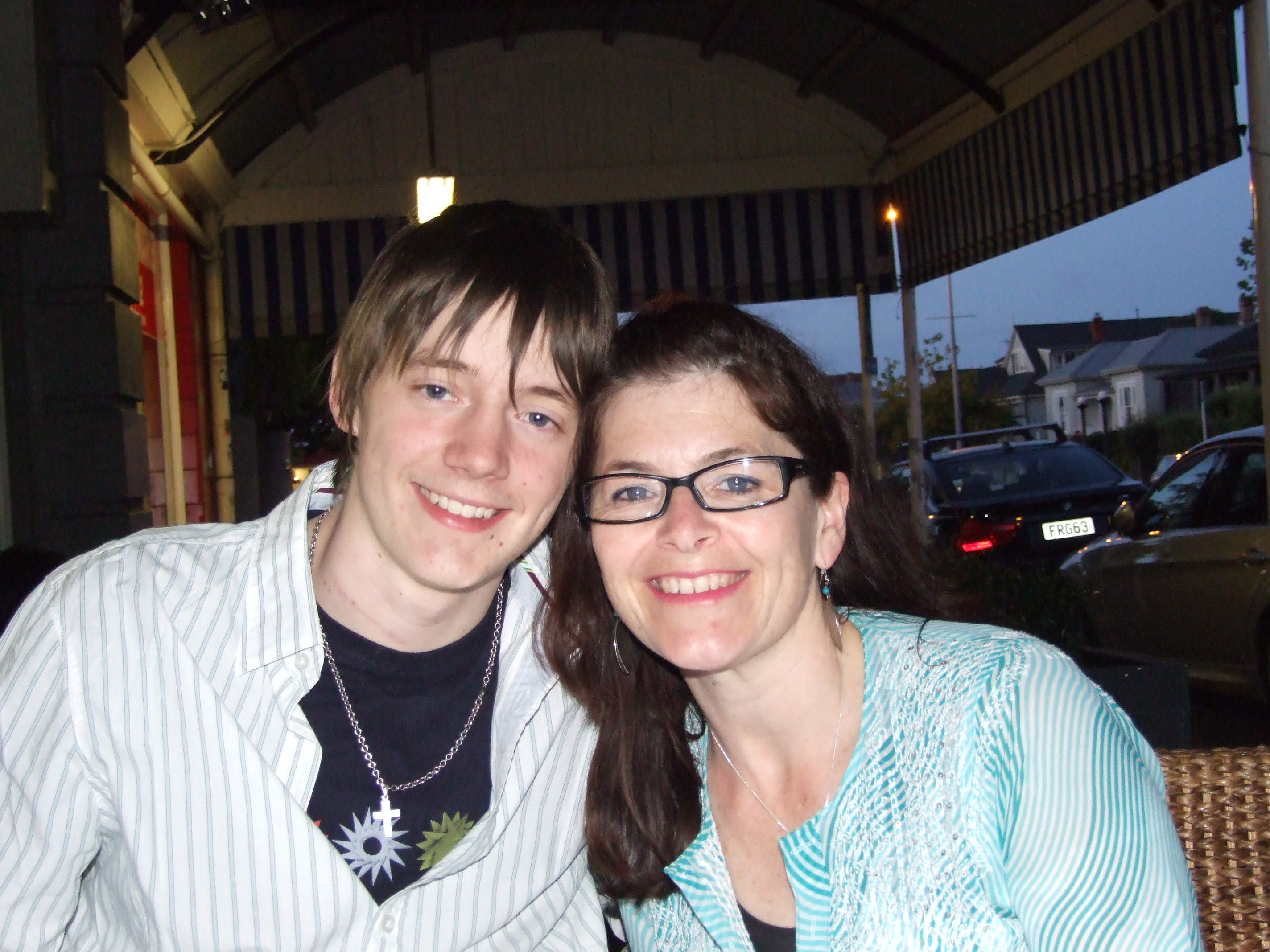Sarah’s story: My journey with Sam
7 June 2017

We were rolled into the world of spinal cord injury in December 2009 when our car hit black ice on a Monday morning as we were heading off from the north east of Scotland for our Christmas holidays. Our car had skidded on the ice, gone down a small embankment, rolled once and landed back on its wheels. There was minimal damage to the car. There was heart-breaking damage to our son, Sam, who was just 17 years old at the time.
The profound heartache I felt in the months that followed, I can still feel now when I dwell on all the complications spinal cord injury brings with it. I am thinking of the limitations imposed by using a wheelchair in a world not universally set up to enable access to all: the implications of catheters and bowel routines; the need to be mindful of skin and pressure risks; the necessity perhaps of equipment like hoists, shower chairs, pressure-relieving mattresses and wheelchair accessible vehicles; the management of medication; and the sheer fatigue that comes with a high level injury, in particular.
How could we avoid letting all these new issues dictate life for Sam primarily, but also for us as a family? I decided, in the end, that for me and, I hoped, perhaps for Sam, one way might be by making sure that the injury did not have the last word even if it had a lot to say about things and how they might be done.
Travel was one of the ways I was determined that we should push back. I felt that if Sam could continue to travel, even if there were some issues, then his horizons would remain wide and his life full of potential and opportunity. I simply could not bear to believe otherwise.
I decided to take him to Australia and New Zealand – two countries we knew well and loved. Although it was a long way away, to me, it was a safe place to start. Sam, still in hospital when I first raised it, probably thought I was crazy – my husband certainly did – but Sam was up for it, if I was.
Sam was discharged from the spinal unit at the end of July 2010. At the end of January 2011, we left for 2 weeks in New Zealand and 4 weeks in Australia. We took during that time 9 flights, we drove 2000 km and we stayed in 14 hotels/units. We had an amazing, exhausting and life-affirming time. However, although it may have seemed crazy to do so much so soon, it was not done in a foolhardy way. Between leaving the unit and leaving the country, we got ready and we practised what we would need to know and do.

Sarah on holiday with her sons, Andrew & Sam
I practised managing Sam’s care so that we could travel without needing a personal assistant and, as a family, we rehearsed what it was like to travel and stay away.
During this period, Sam was also getting stronger and more adept with the movement he did have and gradually progressed to doing assisted transfers with the help of a sliding sheet and transfer board. Strength that also enabled him to move to an e-motion wheelchair rather than being solely dependent on the electric wheelchair with which he had been discharged. This created the option of travelling in an unadapted vehicle if Sam could also learn to transfer, with help, into the front seat of a car. As a result, with the help of Sam’s community physio, we practised that too.
Over those months, we also stayed the odd night away in hotels and discovered just how many ways there are to interpret the word ‘accessible’. As a result, we found it helped to be as prepared as possible by calling or emailing ahead to check exactly what to expect and to clarify what we needed. The need to be organised also became apparent. I would frequently forget to take straws, for example, which was always annoying when trying to give Sam medication if he was lying down , and so the ‘Travel Bible’ was born – a detailed list under key headings of all the different items Sam might need when going away.
It is a folder that also includes a signed medical letter from his doctor detailing the nature of his injury and listing his prescribed medication as well as holding his travel insurance and other documents. On that first trip it also included the details of the closest hospital in each town where we stayed. It was not information I ever needed but I felt more secure having it!
On an equipment level, all these trips were facilitated by the fact that we had bought a collapsible travel shower chair. It is a big and bulky item even once stowed in its bits in its bag but, with it, we can travel anywhere and handle the bowel routine and showering as normal.
Pressure-relief was harder to sort. Initially, I took with me a furry blanket which provided a soft insulating layer between Sam and any buttons that might be on a hotel mattress. However, I still had to turn Sam an exhausting every 2 or so hours to ensure that there was no risk to his skin. More recently, though, we have acquired an air mattress which comes in a cylinder small enough to fit in a cabin bag. It is fabulous! Sam has up to 4 hours sleep in one position on it.
The other essential piece of equipment is a second gel pad. This is just the top gel layer of Sam’s Jay 2 cushion. We bought a second one along with a second cover to put on car and airplane seats so Sam can transfer off one pad on to the other and always be on an appropriate pressure-relieving cushion.
The lessons of our travels can be summarised in three words: prepare, adapt and appreciate. In other words, use the internet or other sources to research and organise your holiday but then follow that up with calls/emails to make sure your needs will be addressed at each stage – by an airline, by a taxi or car hire company, by a hotel or by a restaurant, whatever it might be.
Then with your list in hand and all items ticked off, accept that there may well be nonetheless the need to adapt to the reality on the ground. I stand my ground when Sam’s wellbeing would be compromised but otherwise we work it out and make do. People are generally very helpful and want to make it right when given the chance.
Finally, in the midst of all that preparing and adapting, don’t forget why you set off – to have fun and appreciate each experience.

Sam & Sarah
Since that first big trip, Sam has continued to get stronger. He has left home and has travelled on buses, tubes, trains, trams, planes, ferries, motorboats as well as in taxis and cars. All these journeys continually underline that his life is still full of opportunity; journeys that have helped to steadily piece my broken heart back together as well.
Sam’s Travel Bible
This is our starting point for thinking about what might be needed.
- Wheelchairs
- Recharger(s) including continental or other adapter leads
- Spare inner tubes/outer tyres (depending)
- Extra gel pad and cushion cover
- Sliding sheet
- Transfer Board
- Travel shower chair
- Medication
- All necessary medication listed individually
- Thermometer (not essential but useful)
- Bowels
- Gloves
- Pads
- Wipes
- Relevant medication individually listed
- Bladder (for an indwelling catheter)
- Gourd
- Night drainage bags
- Leg Syphon bags
- Spare tapes
- Spare catheter and related kit
- Catheter flush
- Usual Toiletries plus
- Straws
- Flannels
- Bed
- Mattress topper (air mattress)
- Pillows x 4
- Spare pillow slips
- Blankets x 2
- Food-related
- Thermal-insulated mug
- General
- Intercom system
- Travel ramp
- Glasses (sun, prescription)
- Plug adapters as required for country visited
- Technology rechargers for iPad, iPhone, laptop etc
- Documents
- VE103R certificate if abroad with Motability vehicle
- Passport
- EHIC card
- Insurance policy numbers, contact details for chair, car, health
- Prescription form
If you have any further questions related to travel, please contact our Outreach team or call us on 020 8875 1805.


